|
Oracle® Application Server TopLink Application Developer's Guide
10g Release 2 (10.1.2) Part No. B15901-01 |
|
 Previous |
 Next |
|
Oracle® Application Server TopLink Application Developer's Guide
10g Release 2 (10.1.2) Part No. B15901-01 |
|
 Previous |
 Next |
A session in an OracleAS TopLink application includes a query mechanism that interacts with the database, and an object construction mechanism that builds objects from the data that is stored in the database. The data interaction and object construction components both reside on a JVM. A client application uses these mechanisms to query the database and retrieve objects.
Figure 4-1 Simple OracleAS TopLink Session Architecture
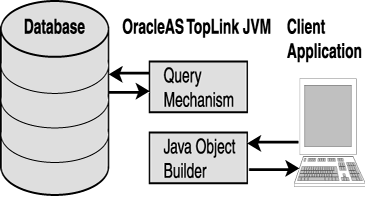
OracleAS TopLink supports the following types of session:
A server session provides a connection with the database and makes the extracted data available to one or more client sessions (either client session or remote sessions). A server session usually appears as part of an OracleAS TopLink three-tier architecture. It uses a JDBC connection pool configured to provide a query mechanism to clients. Client applications communicate with the server session through a client session.
Figure 4-2 Typical OracleAS TopLink Server Session with Client Session Architecture
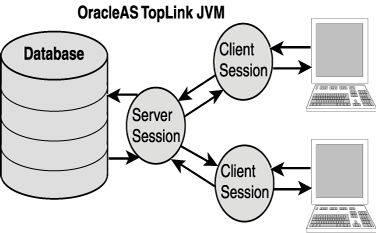
For more information about the server session, see "Server Session and Client Session".
A client session communicates with the server session on behalf of the client application (see Figure 4-2). A server session creates client sessions on request, and the client sessions share an object cache.
Together, the client session and server session provide a three-tier architecture that you can scale easily, by adding more client sessions. Because of this scaleability, we recommend you use the three-tier architecture to build your OracleAS TopLink applications.
For more information about the client session, see "Server Session and Client Session".
A database session provides a client application with a single JDBC database connection, for simple, standalone applications in which a single connection services all database requests for one user.
Figure 4-3 OracleAS TopLink Database Session Architecture
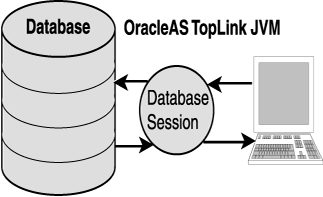
For more information about the database session, see "Database Session".
A remote session is a client-side session that resides on the client rather than the OracleAS TopLink JVM. The remote session does not replace the client session; rather, a remote session requires a client session to communicate with the server session. A remote session can also communicate directly with a database session.
Figure 4-4 Typical OracleAS TopLink Server Session with Remote Session Architecture
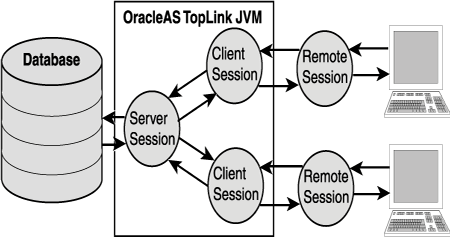
The remote session provides a full OracleAS TopLink session, complete with a session cache, on the client system. OracleAS TopLink manages the remote session cache and enables client applications to execute operations on the OracleAS TopLink JVM.
For more information about the remote session, see "Remote Session".
The OracleAS TopLink session broker enables client applications to view several databases through a single session. If you store objects in your application on multiple databases, then the session broker, which provides seamless communication for client applications, enables the client to view multiple databases as if they are a single database.
The session broker connects to the databases through either a database session or a server session.
Figure 4-5 OracleAS TopLink Session Broker with Server Session Architecture
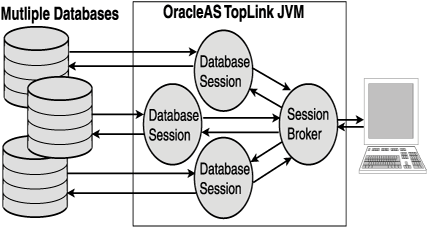
For more information about the session broker, see "Session Broker".